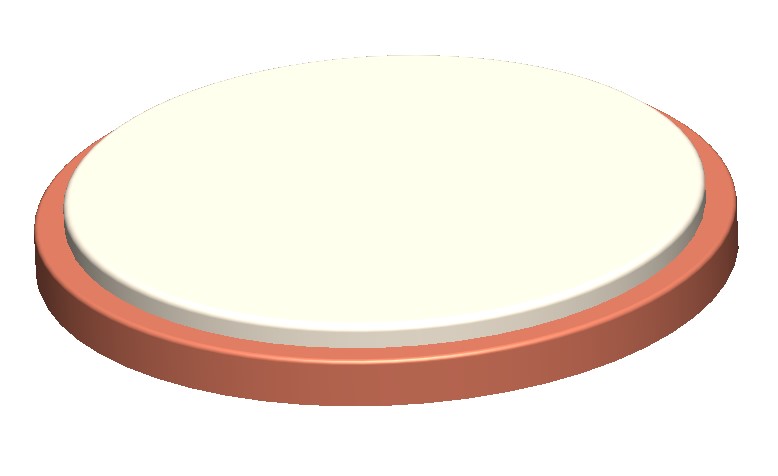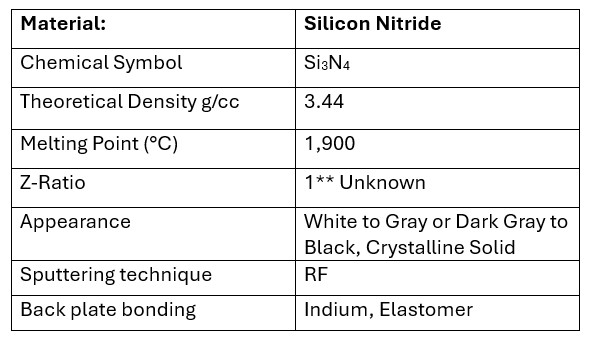Ideal Vacuum Circular Magnetron Sputtering Targets, SILICON NITRIDE- Si3N4 Sputtering Target, 3'' Diameter x 0.125" Thick, 99.5 Percent Purity, Metallic Bonded to a OFHC Copper Backing Plate
Ideal Vacuum Products, LLC.
This product is a circular magnetron SILICON NITRIDE- Si3N4 sputtering target, with a 3'' diameter x 0.125" thickness. It is 99.5% pure, and is metallically bonded to a OFHC (Oxygen-Free High Conductivity) copper backing plate.
We use a very competitive pricing strategy to ensure you receive the highest quality products at the best possible value, giving you both affordability and excellence in every purchase. We offer huge discounts to every customer, customers who place bulk orders will enjoy huge savings. We stock huge quantities of our products to give our customers guaranteed same day shipping after placing an order. This short lead time is loved by all our customers who look to manage their cash flow with quicker turnaround times. Our regular customers can maintain lower inventory levels, decreasing storage costs and minimizing the risk of obsolescence. Buying from Ideal Vacuum means a customer receives their product more quickly, enhancing satisfaction and meeting their urgent needs. This also enables our customers to stay ahead of their competition by quickly adapting to new trends and demands.
SILICON NITRIDE- Si3N4
SILICON NITRIDE- Si3N4, is a versatile material used in thin-film coatings for various applications due to its mechanical, chemical, and optical properties. Here’s a summary of its key characteristics in the context of thin films:
Refractive Index: ~1.9 to 2.0 (at 550 nm), making it a medium-index material often used in multilayer optical coatings.
Optical Properties: Si3N4 has excellent transparency from the visible to the infrared range (~250 nm to 8 µm), making it suitable for anti-reflective coatings, waveguides, and photonics.
Mechanical Properties: It is hard, wear-resistant, and has high thermal stability, making it ideal for coatings that require durability and environmental resistance.
Chemical Stability: Si3N4 is chemically inert and provides good corrosion resistance, which is useful for protective coatings.
Deposition Methods: Si3N4 can be deposited by RF or reactive sputtering (using a silicon target with nitrogen), as well as by PECVD (plasma-enhanced chemical vapor deposition).
Applications: It is commonly used in optical coatings, semiconductor devices, protective coatings, and microelectronics due to its insulating properties and ability to act as a diffusion barrier.
Si3N4 is valued for its combination of optical performance and mechanical strength, making it useful in both functional and protective thin-film coatings.
RF vs DC Sputtering:
RF sputtering is often the preferred method for sputtering pure metallic oxides because they are insulators and RF has an alternating electric field that prevents charge buildup on the target surface. This alternating field reduces the charge accumulation that would otherwise cause arcing in DC sputtering.
Deposition rate:
Lower deposition rate: In RF sputtering, the power transfer to the plasma is less efficient compared to DC, primarily due to the alternating nature of the electric field. This results in a lower deposition rate compared to DC sputtering under equivalent power conditions.
Target Material:
For conductive targets (like titanium in reactive sputtering), DC sputtering has a higher deposition rate. For insulating targets like pure metal oxides, RF sputtering must be used, and deposition rates are typically lower.
Power Levels:
Increasing the power can increase deposition rates in both RF and DC sputtering, but deposition rates still tend to be higher in DC for conductive materials.
Pressure and Gas Flow:
Higher deposition rates can be achieved by optimizing the gas pressure and flow, with different optimal conditions for RF vs. DC.

 Notes:
Notes:
Metallic or elastomer backing plate bonding is recommended for all dielectric target materials because these materials have characteristics which are not amenable to sputtering, such as, brittleness and low thermal conductivity. These targets are most susceptible to thermal shock due to their low thermal conductivity and hence, may require specific power ramp up and ramp down procedures during start up and shut down steps.

